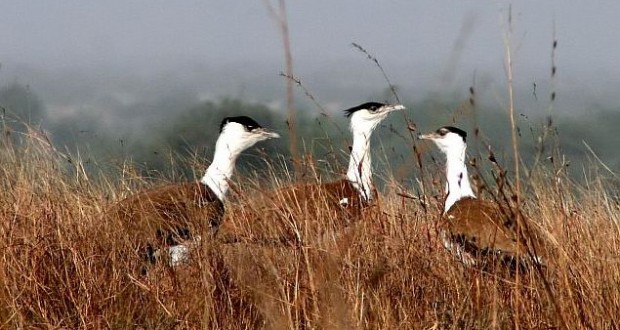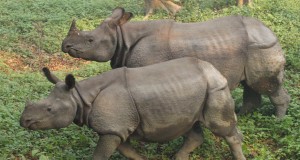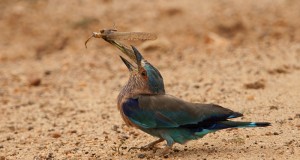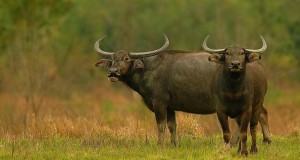A desert environment is one where two basic needs of life — water and shelter, are at a premium and, therefore, it is not a biome in which any lifeform is likely to have originated. The story of life here is one of the heroic struggle of the survivors who adopted a strategy to withstand the harsh physical 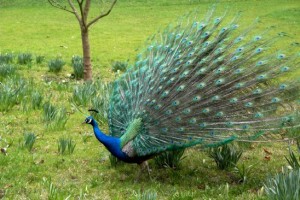 conditions — extreme paucity or total absence of free water, inhibitive high temperatures reaching over 130°F (55°C), and desiccation augmented by hot winds. At the other extreme, low temperatures, below zero, accentuated by bitter cold Himalayan winds are another challenging factor in certain deserts. Since the desert landforms of the world are far more recent (about 7 million years old) than the rain forests, the adaptations are often not in physical form but in behavioral pattern — an example of marvelous ecological adjustment rather than evolution.
conditions — extreme paucity or total absence of free water, inhibitive high temperatures reaching over 130°F (55°C), and desiccation augmented by hot winds. At the other extreme, low temperatures, below zero, accentuated by bitter cold Himalayan winds are another challenging factor in certain deserts. Since the desert landforms of the world are far more recent (about 7 million years old) than the rain forests, the adaptations are often not in physical form but in behavioral pattern — an example of marvelous ecological adjustment rather than evolution.
The strenuous life activities of desert wildlife are concerned mainly with getting water, conserving this important resource, avoiding overheating, getting enough food, and avoiding and escaping from enemies while exposed in the coverless landscape. 
The Great Indian Desert, also known as the Thar Desert, is situated between 22° and 32° north latitude in the states of Rajasthan and Gujarat, and lies across India’s western frontier with Pakistan. It extends over 270,200 sq miles (700,000 sq km). Landforms such as shifting sand dunes, fixed sand dunes, interdunal lands, rocky outcrops, flat pavements and salt flats of ephemeral lakes are some of the habitat types of the Thar. These are inhabited by a rich variety of plant and animal life.
Base of Life: The Thar Desert is distinct in vegetative biomass, specially the sewan grass which covers extensive areas called pall. Typ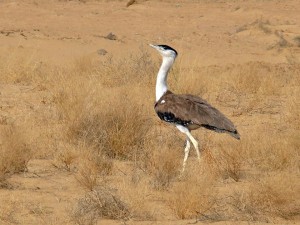 ical shrubs are phog ( Calligonum pollinoides) growing on sand dunes, khair ( Capparis decidua), a leafless shrub growing to a middle-size tree, aak (Caloiropis procera) and thor (Euphorbia caduca), representing the juicy shrubs. Jal (Salvadora procera), khejra ( Prosopis sinreria) and rohira ( Tecoma undulata) are the main trees scattered very thinly over the desert. There are no cacti and there is no carpet of flowers of annuals. But khair, rohira and aak, when in flower in March, add color to the landscape and are the center of activity for insects and birds.
ical shrubs are phog ( Calligonum pollinoides) growing on sand dunes, khair ( Capparis decidua), a leafless shrub growing to a middle-size tree, aak (Caloiropis procera) and thor (Euphorbia caduca), representing the juicy shrubs. Jal (Salvadora procera), khejra ( Prosopis sinreria) and rohira ( Tecoma undulata) are the main trees scattered very thinly over the desert. There are no cacti and there is no carpet of flowers of annuals. But khair, rohira and aak, when in flower in March, add color to the landscape and are the center of activity for insects and birds.
Most of the major insect orders are found in the Thar Desert. There are 17 species of termites. The colorful members are the butterflies of the group Lepidopiera. The dung beetle ( Coleopiera ordes) which rolls dung balls larger than itself, has an advanced form of a “copter” mechanism. Its flight wings, neatly placed under a hard cover, slide out as if under electronic automation for take off. The hot sandy areas arc ideal for swarms of locusts and grasshoppers, many of which are brightly colored. The velvet mite which has disappeared from many areas due to chemical sprays, is still to be seen in the desert. Moisture is the governing factor of all insect activity and insects spring to life with the first monsoon shower. They constitute an important source of protein for insectivorous birds and reptiles and even mammals, and being 60-85 percent water, a source of water too. They are thus an important ecological link as first-stage consumers and act as producers for the second-stage consumers— reptiles and birds.
Reptiles: Forty-three reptile species inhabit the Indian desert today. The spiny-tail lizard (Uromasiix hardwickel) lives in underground c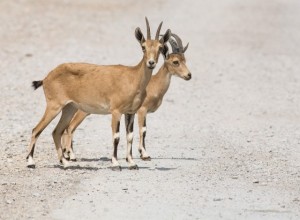 olonies in flat calcareous interdunal areas and kankar (limestone) pans. Its L-shaped burrow is six-eight inches (15-20 cm) deep. Its design helps in withstanding sudden changes of weather conditions. The burrow is held exclusively by the owner. With a few drops of rain falling, one can observe the process of closing the hole. With moisture in the air, the calcareous nature of the soil helps to seal the opening. The excavated earth heaped around the hole acts as a check-dam against sheet run-off of the rain water.
olonies in flat calcareous interdunal areas and kankar (limestone) pans. Its L-shaped burrow is six-eight inches (15-20 cm) deep. Its design helps in withstanding sudden changes of weather conditions. The burrow is held exclusively by the owner. With a few drops of rain falling, one can observe the process of closing the hole. With moisture in the air, the calcareous nature of the soil helps to seal the opening. The excavated earth heaped around the hole acts as a check-dam against sheet run-off of the rain water.
Though a snake called pivana (breath sucker) has been identified as the Sind krait ( Bungarus caevuleus), myths about the breath-sucking power of the viper continue to circulate all over the desert. It is the snake of the desert’s core area. The deadly saw-scaled viper ( Edits caenatus), another poisonous snake, does not leave a serpentine mark on the sand. Its almost parallel lines created by its looping movement, leave no clue of its direction of movement. The color of the Russel’s viper ( Vipers russet”) matches that of the sand so well that only by scanning the ground inch by inch can one discover the serpentine spring, ready to uncoil and attack.
Desert monitors ( Varanus griseus and Varanus bengalensis) are miniature dragons with dinosaurian looks. They raid nests, and feed on rodents and insects. The toad agama or horned toad, curiously named since it is no toad and has no horn, is actually a lizard. The blue, green, yellow, crimson, red and black spots in contrast to its sand-colored body, make it colorful. It screws itself into loose sand, to “swim” under it to escape predators. The sandfish ( Ophiomorus tridactvlus) is another lizard which swims under sand. The color-changing chameleons are commonly seen on the bushes and trees looking for insects.
Wings of the Desert: The avifauna of the desert is rich in both species and in population — numbers sometimes swelling to 2000 4000 birds at a single spot. No niche of the Thar is devoid of birds. Even in the face of challenging terrain, temperature and repeated deadly droughts, many species of b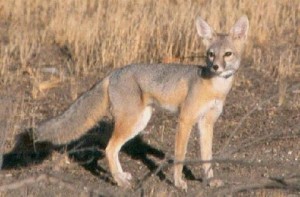 irds have decided to be resident here.Outstanding among the birds is the great Indian bustard (Chriotis nigricaps). It weighs 18-30 lb (eight-14 kg) and stands 16″ (40 cm) high on strong legs designed for walking. This tall, heavy bird can be seen walking with confidence and grace in the desert. It holds its head at an angle; its body feathers form a pattern of black bars and dots; its head looks like a crown; its snow-white neck makes it conspicuous in the landscape. While changing its feeding grounds or to escape danger, the bird reluctantl y takes to wing. The bustard feeds on a varied diet cereals, grasshoppers, locusts, dung beetles, lizards, snakes, berries and small, sparrow-size birds. It lives in family flocks of four-six but at times over 40 birds assemble on a feeding or breeding ground. A polygamous male every now and then inflates its neck air-sac and fluffs its feathers to display its size to court females.
irds have decided to be resident here.Outstanding among the birds is the great Indian bustard (Chriotis nigricaps). It weighs 18-30 lb (eight-14 kg) and stands 16″ (40 cm) high on strong legs designed for walking. This tall, heavy bird can be seen walking with confidence and grace in the desert. It holds its head at an angle; its body feathers form a pattern of black bars and dots; its head looks like a crown; its snow-white neck makes it conspicuous in the landscape. While changing its feeding grounds or to escape danger, the bird reluctantl y takes to wing. The bustard feeds on a varied diet cereals, grasshoppers, locusts, dung beetles, lizards, snakes, berries and small, sparrow-size birds. It lives in family flocks of four-six but at times over 40 birds assemble on a feeding or breeding ground. A polygamous male every now and then inflates its neck air-sac and fluffs its feathers to display its size to court females.
Overhunting, since it provided substantial meat, trampling of its eggs (generally one, sometimes two and rarely four) by cattle, and loss and disturbance in its habitat, had not long ago reduced its numbers to near extinction. Thanks to public awareness and conservation efforts, including establishment of the Desert National Park, the bustard population has recovered and is now placed at over 1000 in the desert alone.
The morning silence of the desert is broken by a sudden twitter in the sky and one spots the flight of a distant pair. A few more definite and louder twitters are heard in the same direction. These are the Indian sandgrouse (Pleroc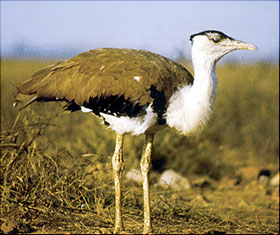 les exustus ) flying for their morning drink. At a water hole they wheel and turn to land, first at some distance from the free water and later directly on the water hole. Soon they crowd in hundreds for the day’s sip and take off, to return the next day — the same place, the same time. They live in small flocks of 10-15. They are distinguished by the male’s chestnut band on his chest, spots on the body and a tapering long pintail. Similar is the watering behavior of painted and spotted sandgrouse. They feed on grass and grains and pick up grit to grind the grain between their powerful gizzard muscles.
les exustus ) flying for their morning drink. At a water hole they wheel and turn to land, first at some distance from the free water and later directly on the water hole. Soon they crowd in hundreds for the day’s sip and take off, to return the next day — the same place, the same time. They live in small flocks of 10-15. They are distinguished by the male’s chestnut band on his chest, spots on the body and a tapering long pintail. Similar is the watering behavior of painted and spotted sandgrouse. They feed on grass and grains and pick up grit to grind the grain between their powerful gizzard muscles.
The gray partridge ( Francolinus pondicerinus) is known for its morning call and its elegant walk. It is the only species of the Francolinus genus that dares to live in the harsh desert. Its secret is its comparatively low dependence on drinking water. It lives in family coveys of eight-10 birds but separates in pairs for breeding in spring. 
The bush quail (Perclicula asiatica) and the common quail ( Coturnix colurnix) only inhabit the favorable fringes of the desert; they do not reach the core. The peafowl (Pavo cristalus) and roseringed parakeet ( Psittacula krameri) live only close to human settlements where water is available and can hardly be called desert birds in the true sense. Ring doves (Streptopelia decaocto) are common and congregate at watering places in hundreds. Spotted doves and red turtle doves are seldom seen.
Insectivorous birds like the bee-eater ( Merops supercilious ), blue tailed bee-eater ( Merops Philippines), common bee-eater (Merops orientalist ), Indian roller ( Coracias hengalensis), larks, shrikes, orioles, dron gos, babblers, flycatchers and warblers enrich the avifauna. Among bulbuls, the white-cheeked bulbul (Pycnonolus leucogenys) is commonly seen on khair bushes.Sparrows, including the house-sparrow (Passer clomesticus inclicus) and Spanish sparrow ( Passer hispaniolensis) fly in gliding movements and congregate on khair bushes near water holes in incredible numbers. They are in constant motion, diving into the leafless bush every time a predatory bird makes a swoop. Whitethroated munia (Lonchura malabarica) gather in small flocks and perch on dry bushes.
gos, babblers, flycatchers and warblers enrich the avifauna. Among bulbuls, the white-cheeked bulbul (Pycnonolus leucogenys) is commonly seen on khair bushes.Sparrows, including the house-sparrow (Passer clomesticus inclicus) and Spanish sparrow ( Passer hispaniolensis) fly in gliding movements and congregate on khair bushes near water holes in incredible numbers. They are in constant motion, diving into the leafless bush every time a predatory bird makes a swoop. Whitethroated munia (Lonchura malabarica) gather in small flocks and perch on dry bushes.
Winter Visitors: The desert even attracts many visitors! Its rich food supply, clear, storminess weather, warm, sunny days and clear comfortable nights, attract birds of the temperate region. Hundreds of thousands of common crane ( Grus grus) and demoiselle crane (4nthropoides virgo) pass through the desert during October on their to and fro winter migration. The cranes live in grassy depressions and along salt flats like Tal Chhapar, Kanodia Tall, the flood flanks of the Luni river and  shallow drying lakes and open agricultural fields in the Saurashtra region of Gujarat. The graceful greater flamingo ( Phoenicopterus roscus) and the colorful lesser flamingo (Phoenieopterus minor) visit the shallow saline lakes all over the desert, including Sultanpur near Delhi. Their assemblies of over a thousand birds are seen in several places. In May and June, at Nal Sarovar (Gujarat) over 100,000 of these birds congregate. They probably assemble every summer to locate sites for their nesting somewhere in the Greater Rann of Kutch.
shallow drying lakes and open agricultural fields in the Saurashtra region of Gujarat. The graceful greater flamingo ( Phoenicopterus roscus) and the colorful lesser flamingo (Phoenieopterus minor) visit the shallow saline lakes all over the desert, including Sultanpur near Delhi. Their assemblies of over a thousand birds are seen in several places. In May and June, at Nal Sarovar (Gujarat) over 100,000 of these birds congregate. They probably assemble every summer to locate sites for their nesting somewhere in the Greater Rann of Kutch.
The saline ponds in the process of drying, if they happen to hold enough water till winter, attract rosy and gray pelicans ( Pelecanus onocrotalus and P. phihppensis philippensis) and migratory waterfowl—barheaded geese (Anser indicus), whistling teal ( Dendrocygna javanica), ruddy shelduck ( T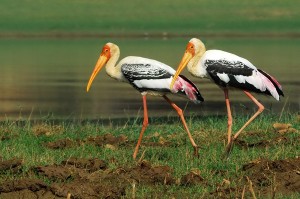 adorna ferruginea), pintail (Anas acuta), shoveler (Anas erecca), coot ( Fulica atra), and waders including curlew, sandpiper ( Calidris teslaceus) and snipe ( Capella sops).A significant recent event in Indian ornithology was the establishment of the fact that the desert courser ( Cursorius eoromandelieus) nests in the Indian desert. This bird is cream-colored and arrives in November to feed on termites and insects. The Kashmir roller ( Coracias garrulus) arrives by October and stays till March. In contrast, orioles ( Oriolus oriolus) visit the desert in hot summer and delight one with their melodious note. Migration of rosy pastors (Slurnus roseus) and starlings (Slurnus vulgaris) in swarms across the desert is seen once in October and on their return flight in February – M arch.
adorna ferruginea), pintail (Anas acuta), shoveler (Anas erecca), coot ( Fulica atra), and waders including curlew, sandpiper ( Calidris teslaceus) and snipe ( Capella sops).A significant recent event in Indian ornithology was the establishment of the fact that the desert courser ( Cursorius eoromandelieus) nests in the Indian desert. This bird is cream-colored and arrives in November to feed on termites and insects. The Kashmir roller ( Coracias garrulus) arrives by October and stays till March. In contrast, orioles ( Oriolus oriolus) visit the desert in hot summer and delight one with their melodious note. Migration of rosy pastors (Slurnus roseus) and starlings (Slurnus vulgaris) in swarms across the desert is seen once in October and on their return flight in February – M arch.
The houbara ( Chlamvdolis undulate mac-gueenii) hit world headlines in the late 1960s when some oil-rich Arabs managed to persuade the Indian Government to permit them to hunt the birds with falcons. This “sport” created a problem since the size of the bag became a status symbol with the sheiks. The hunts played havoc with the population of this lesser bustard. In 1978, as a result of countrywide protest, this sport was ended once and for all.
The sandgrouse, identified by its black lowerhalf belly and wing tips, is a gregarious bird. Large flocks of them visit water holes for a morning drink. They come in hundreds and thousands, without a single twitter. All one hears is the soft, whistling wing beats of the flying birds wheeling, landing and taking off.The large pintail sandgrouse flies into the area in large flocks during winter, but not as large as reported by Alan Octavian Hume in the late 19th Century as “tens of thousands — like a thin cloud darkening the air.”
Antelope Territory: The core of the desert ecosystem is the prim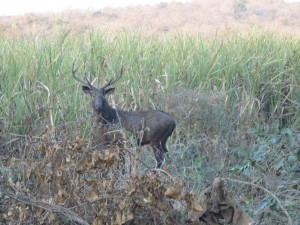 e habitat of the true antelope, the blackbuck (Antelope cervicapra). It inhabits the open plains, short grasslands and saline depressions called chappar or rann. It depends for its survival on its keen sight and high speed (40 miles/ 60 km per hour) with occasional leaps. It lives in large herds of 40 to 60 animals, mostly fawns and fawn-colored females and a few jet black, dominant, co-dominant, and lightcolored, recessive bucks. The does are hornless, whereas the bucks have a pair of spiraled horns ending in a rapier-sharp tip which lends the buck a masculine magnificence.
e habitat of the true antelope, the blackbuck (Antelope cervicapra). It inhabits the open plains, short grasslands and saline depressions called chappar or rann. It depends for its survival on its keen sight and high speed (40 miles/ 60 km per hour) with occasional leaps. It lives in large herds of 40 to 60 animals, mostly fawns and fawn-colored females and a few jet black, dominant, co-dominant, and lightcolored, recessive bucks. The does are hornless, whereas the bucks have a pair of spiraled horns ending in a rapier-sharp tip which lends the buck a masculine magnificence.
Ferocious combats of territorial blackbuck are common. Rival bucks are chased away and the 20-30 doe harem is regrouped with an impressive display of speed and determination. They are short-grassland animals. They are water-dependent, and, therefore, do not venture into the waterless region of the desert. However, even highly brackish water is acceptable to them. 
The buck was once the dominant mammal of the desert region but, as a result of merciless persecution over 50 years, it is now confined only to certain pockets. It is estimated that there are 15,000 in Jodhpur District in areas which have been notified for strict protection, but the most impressive of them are to be seen in the Velavadar National Park in Gujarat where more than 2500 of them live in a short-grassland area of less than 14 sq miles (36 sq km).
Striding across clumps of grass, the gazelle, or ehinkara as it is also called, stops only on the crest of a sand dune. One wonders why this animal, having pointed hooves unsuited to walking on loose sand, has chosen to live in the des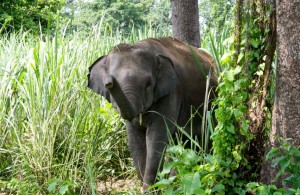 ert. In fact, sand dunes form less than 10 percent of the Great Indian Desert, the other 90 percent of landforms include craggy rocks pavements, and compacted salt-lake bottoms, interdunal areas, and fixed dunes, for which the gazelle is well equipped to fly over at high speed. The gazelle is the only species of the Indian antelope of which the female have horns, vestigial though they be. The horns of males are over nine inches (23 cm) long and are pointed at the tip, well adapted for a fight to the finish. The chinkara buck is able to stand up to desert predators, including large eagles and foxes.
ert. In fact, sand dunes form less than 10 percent of the Great Indian Desert, the other 90 percent of landforms include craggy rocks pavements, and compacted salt-lake bottoms, interdunal areas, and fixed dunes, for which the gazelle is well equipped to fly over at high speed. The gazelle is the only species of the Indian antelope of which the female have horns, vestigial though they be. The horns of males are over nine inches (23 cm) long and are pointed at the tip, well adapted for a fight to the finish. The chinkara buck is able to stand up to desert predators, including large eagles and foxes.
Normally, one fawn (rarely two) is dropped after eight months of gestation. The most vulnerable period in the life of the gazelle is the period of parturition. But nature’s scheme of protection by camouflage, and literally getting a fawn up on its legs in four-six hours, helps the newborn infant to follow its mother to safety. But its principal survival strategy is to manage in situations of total absence of free water. It manages even where rain is a rare and chance occurrence and year after year may pass without even a trace of water vapour in the atmosphere. The gazelle is able to survive in these conditions -because it has an inbuilt adaptive system to produce metabolic water in the physiological process of digestion. Its kidney chemistry is such that it can excrete highly concentrated urine, thus helping the body to economize on water.
The gazelle is well distributed throughout the desert. There are some pockets where it is much less wary than elsewhere because it has received protection from the desert’s human inhabitants, specially the Bishnois, and even the meat-eating Muslims.
The third member of the antelope group (not the family) is the nilgai ( Boselaphus tragocamelus), the largest antelope of India. Ecologically, the animal’s heavy demand on forage is not in the interest of the meager forage resources of the desert and, therefore, its water-dependence has discouraged its distribution in the heartland of the Thar. It is actually the female that is called nilgai (blue cow) and the male, blue bull, though they have no resemblance to or relationship with the sacred cow. The bull is strong, with spiky horns totally ut of 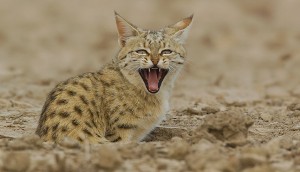 proportion to its body size; they are more like spurs at the wrong place. However, they are effective and efficient in ripping open a rival male during courtship quarrels. The fights between bulls are highly ritualized, starting with a slyly at each other from the corner of their eyes. They move in closing circles, finally falling on their knees, trying to get at each other’s vulnerable points. The victim is chased out of the victor’s territory enclosing the cows in estrus. Though the right of exclusive mating is fully demonstrated by the leader, recessive males sneak in to cover the cows while the dorhinarit male is busy chasing away his rivals. After eight months of gestation, around September, when grasses and cover are sufficient, one fawn (occasionally two) is dropped. The increasing number of nilgai in certain areas, in the absence of a predator, is becoming a problem.
proportion to its body size; they are more like spurs at the wrong place. However, they are effective and efficient in ripping open a rival male during courtship quarrels. The fights between bulls are highly ritualized, starting with a slyly at each other from the corner of their eyes. They move in closing circles, finally falling on their knees, trying to get at each other’s vulnerable points. The victim is chased out of the victor’s territory enclosing the cows in estrus. Though the right of exclusive mating is fully demonstrated by the leader, recessive males sneak in to cover the cows while the dorhinarit male is busy chasing away his rivals. After eight months of gestation, around September, when grasses and cover are sufficient, one fawn (occasionally two) is dropped. The increasing number of nilgai in certain areas, in the absence of a predator, is becoming a problem.
The pale-chestnut-colored wild ass (Asinus hemionus khur) of the desert is a fascinating creature — for its survival capacity, if for nothing else. Its body cells are capable of withstanding dehydration and also have the capacity of holding reserves of water when it is available — a perfect adaptive strategy in the harsh environment of the desert. The wild ass, an animal of the open sandy desert, is now confined to the Little Rann of Kutch. Its withdrawal from the sandy tracts to the bet (islands) in the Rann is recent. These “islands” within the temporary marshes provide a protected habitat to this endangered population,  and hence its withdrawal there. Unfortunately, even from these bets the cattle of the Maldharis are edging the wild ass out. They now live mostly in Prosopis juliflora bushes, a modified habitat, on the fringes of the Rann. The bushes provide good cover and their dry pods a sugar-rich diet. Normally, the ass feeds on grasses, salt-tolerant bushes and even dry leaves of aak (Caloiropis procera). Like the antelope, this species relies on its keen sight and speed for its safety. It is capable of running at 40 miles (60 km) an hour. The wild ass lives in herds of 30 to 40 members (sometimes as large as 100) under the leadership of a stallion who guides the direction of movement. Their current population is estimated to be somewhat over 1000 animals, all in the Little Rann.
and hence its withdrawal there. Unfortunately, even from these bets the cattle of the Maldharis are edging the wild ass out. They now live mostly in Prosopis juliflora bushes, a modified habitat, on the fringes of the Rann. The bushes provide good cover and their dry pods a sugar-rich diet. Normally, the ass feeds on grasses, salt-tolerant bushes and even dry leaves of aak (Caloiropis procera). Like the antelope, this species relies on its keen sight and speed for its safety. It is capable of running at 40 miles (60 km) an hour. The wild ass lives in herds of 30 to 40 members (sometimes as large as 100) under the leadership of a stallion who guides the direction of movement. Their current population is estimated to be somewhat over 1000 animals, all in the Little Rann.
Underground Dwellers: The desert gerbil (tleriones hurranae) has adapted itself to living in extreme climates with temperatures of over 120°F (50°C) in summer and freezing nights in winter, when the temperature falls below zero. The hot winds, call loo, enhance desiccation, and cold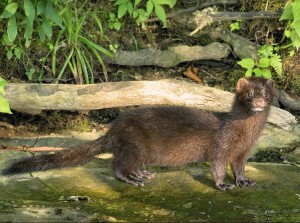 winds from the Himalaya increase the chill at night. The gerbil’s strategy for desert living is to burrow in the ground, where its living chambers are cooler by 40 percent and more humid by 45 percent than at the surface in summer and warmer by 70° F (20° C) in winter. It is active in the late evening, when the temperature is comfortable. It changes its feeding timetable in winter by becoming totally diurnal. Dr. Ishwari Prakash and his team have experimented on the desert gerbil, feeding their sample on 100 percent dehydrated food for 21 months, without any adverse effect on the rodent’s health. The secret of living without water, for months and even years, is its metabolic chemistry which, during the process of digestion, produces water.
winds from the Himalaya increase the chill at night. The gerbil’s strategy for desert living is to burrow in the ground, where its living chambers are cooler by 40 percent and more humid by 45 percent than at the surface in summer and warmer by 70° F (20° C) in winter. It is active in the late evening, when the temperature is comfortable. It changes its feeding timetable in winter by becoming totally diurnal. Dr. Ishwari Prakash and his team have experimented on the desert gerbil, feeding their sample on 100 percent dehydrated food for 21 months, without any adverse effect on the rodent’s health. The secret of living without water, for months and even years, is its metabolic chemistry which, during the process of digestion, produces water.
The gerbil lives in colonies, sometimes in open fixed dunes, but mostly under khair or zizyphus bushes. The burrows are interconnected and have many escape routes. It feeds on grass seeds, fallen fruits and even stems. It also eats insects. Its long bushy tail is its rudder to balance and guide its direction while taking long leaps. The rich population, 800 burrows per hectare, provide sufficient food as well as water (since 65 percent of its body is water) to its predators. Other common  rodents of the desert arc the desert hare ( Lepus nigricollis dayanus) and the hedgehog ( Hemiechinus azurites). The hare is a fast runner and depends on its camouflage coloration when an enemy approaches. The hedgehog is purely nocturnal and rolls itself into a spiny unappetizing ball. The hare is purely vegetarian and the hedgehog an insectivorous rodent. Both live in burrows. The common hare (Lepus nigricollis), with gray or black nape needs proximity to water. It is distributed on the fringes of the desert. The crested porcupine (Hysteria indica) occurs in the hilly terrain of Jalore and Siwana. It is totally nocturnal.
rodents of the desert arc the desert hare ( Lepus nigricollis dayanus) and the hedgehog ( Hemiechinus azurites). The hare is a fast runner and depends on its camouflage coloration when an enemy approaches. The hedgehog is purely nocturnal and rolls itself into a spiny unappetizing ball. The hare is purely vegetarian and the hedgehog an insectivorous rodent. Both live in burrows. The common hare (Lepus nigricollis), with gray or black nape needs proximity to water. It is distributed on the fringes of the desert. The crested porcupine (Hysteria indica) occurs in the hilly terrain of Jalore and Siwana. It is totally nocturnal.
Predators: The main predator of the desert is the Indian wolf (Canis lupus). Once widely distributed over the desert, preferring hilly and broken cou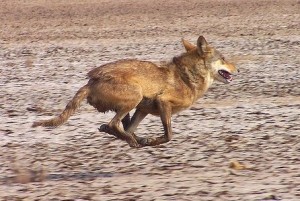 ntry, after massive destruction of the antelope, the wolf was forced to take to preying on sheep and goats and it soon became the shepherd’s nightmare. It was therefore singled out for destruction, to be killed by any means, including smoking mothers and their pups to death in burrows. This very nearly dropped the final curtain for the species in the desert. It is now reduced to a dangerously low number, extremely limited in its distribution.The Indian wolf preys not by chase but by surprise attack and, therefore, does not need the company of other wolves. It lives in pairs or family packs and sometimes organizes cooperative hunting.
ntry, after massive destruction of the antelope, the wolf was forced to take to preying on sheep and goats and it soon became the shepherd’s nightmare. It was therefore singled out for destruction, to be killed by any means, including smoking mothers and their pups to death in burrows. This very nearly dropped the final curtain for the species in the desert. It is now reduced to a dangerously low number, extremely limited in its distribution.The Indian wolf preys not by chase but by surprise attack and, therefore, does not need the company of other wolves. It lives in pairs or family packs and sometimes organizes cooperative hunting.
The jackal ( Canis aureus), widely believed to -; strictly a scavenger, is also an effective predator, specially when helpless does are parturient and the fawns are too weak to stand. It is absent in the core area of the desert owing to its need for water.The common fox ( Vulvas bengalensis) and the desert fox ( Vulpes vulvas) are both widely but thinly distributed throughout the desert region. The common fox, distinguished by the black tip on its tail, is aggressive. It attacks gazelle and kills fawns and even grown females. The desert fox preys only on rodents, gerbils, desert hare, birds, and reptiles like the spiny-tail lizard. A fox hole, specially when it has pups in it, is often located under the same bushes as those of the gerbils and in the midst of hundreds of their burrows. Why predator and prey live in such deadly proximity is still unexplained. The fox hunts during the cooler hours of the day to avoid over-consumption of water which it obtains only from its prey.
There are also the predators of the air. The blackwinged kite (Elands caeruleus), crested honey-buzzard ( Pernis ptilorhynchus ), shikra (Accipiter badius ), tawny eagle (Aquila rapax) and laggar falcon ( Falco biarmias jugger), stay all the year round and nest in the desert. The owls and nightjars take over at night. The short-eared owl (Asio flammeus) and spotted owlet ( Athea hrama) 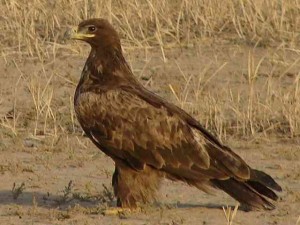 are common. But the majority of the avian predators arrive almost with the influx of the prey birds. They include the goshawk ( Accipiter gentiles ), sparrowhawk (A ccipiter nisus), long-legged buzzard ( Butea refines), desert buzzard ( Butea vulpinus), Boneless hawkeagle ( Hieraetus fasciatus), steppe-eagle ( Aquila nipalensis), greater spotted eagle (Aquila clang), lesser spotted eagle (Aquila pornarina ), Lanner falcon (Falco biarmias cherrug), peregrine falcon ( Falco peregrinus), oriental hobby ( Falco severus) and kestrel ( Falco tanzunculus).
are common. But the majority of the avian predators arrive almost with the influx of the prey birds. They include the goshawk ( Accipiter gentiles ), sparrowhawk (A ccipiter nisus), long-legged buzzard ( Butea refines), desert buzzard ( Butea vulpinus), Boneless hawkeagle ( Hieraetus fasciatus), steppe-eagle ( Aquila nipalensis), greater spotted eagle (Aquila clang), lesser spotted eagle (Aquila pornarina ), Lanner falcon (Falco biarmias cherrug), peregrine falcon ( Falco peregrinus), oriental hobby ( Falco severus) and kestrel ( Falco tanzunculus).
The Thar is overcrowded with cattle, and hundreds of them die every day, leaving enough for the vultures to scavenge. The common among them are the whiteback ( Gips bengalensis), longbilled ( Gyps indicus) and Egyptian vulture ( Beophron percnoplerus ). The king vulture ( Torgos calvus ) is present in small numbers, mostly in pairs. The vultures cope with the arid climate and high temperature by shifting vertically. After an early morning meal, they soar at 3000-4000 feet (910- 1210 meters) in the cool air and descend only in the evening to roost.
The wide faunal spectrum of the Indian desert — insect to antelope and wolf — and its unique life-style,  represent a finely balanced biological pyramid. But in the present context of “development plans,” and the dream of “making the desert bloom,” the Indian desert is in danger. It is already the most crowded desert of the world. The additional water, more cattle and more men being introduced in large numbers, will increase congestion and destroy its essential nature. Much has already been destroyed by excessive cattle grazing, reckless killing of wild animals, removal of the natural vegetation for fuel and even depletion of its undergrounds water.
represent a finely balanced biological pyramid. But in the present context of “development plans,” and the dream of “making the desert bloom,” the Indian desert is in danger. It is already the most crowded desert of the world. The additional water, more cattle and more men being introduced in large numbers, will increase congestion and destroy its essential nature. Much has already been destroyed by excessive cattle grazing, reckless killing of wild animals, removal of the natural vegetation for fuel and even depletion of its undergrounds water.
This landform with its impressive and inspiring philosophy of living on a bare minimum—a lesson in ecological humility, deserves to be understood better. The Great Indian Desert, colorful and living with its natural wildlife, needs a better deal since it is India’s only gene pool of drought-resistant species. It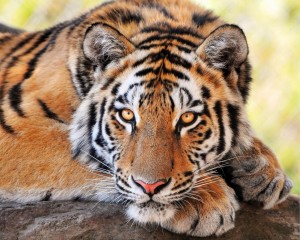 needs greater care in handling than other ecosystems, since it is one of the most fragile. An attempt to salvage a tiny dot 1160 sq miles (3000 sq km) out of 270,200 sq miles (700,000 sq km) of natural desert, was made by establishg a Desert National Park 28 miles (45 km) west of Jaisalmer, to preserve a sample of the discipline of the desert. Despite its initial encouraging start, specially the steps taken to rebuild populations of vanishing species like the desert fox and the great Indian bustard, and preserving the spectacle of the landing sandgrouse and flocks of houbara, there has subsequently been some slackening of effort. Renewed and intensified action, including an expansion of the area of the park, is urgently called for if the initial progress is to be consolidated (indeed, if it is not to be lost). Is anybody listening?
needs greater care in handling than other ecosystems, since it is one of the most fragile. An attempt to salvage a tiny dot 1160 sq miles (3000 sq km) out of 270,200 sq miles (700,000 sq km) of natural desert, was made by establishg a Desert National Park 28 miles (45 km) west of Jaisalmer, to preserve a sample of the discipline of the desert. Despite its initial encouraging start, specially the steps taken to rebuild populations of vanishing species like the desert fox and the great Indian bustard, and preserving the spectacle of the landing sandgrouse and flocks of houbara, there has subsequently been some slackening of effort. Renewed and intensified action, including an expansion of the area of the park, is urgently called for if the initial progress is to be consolidated (indeed, if it is not to be lost). Is anybody listening?

